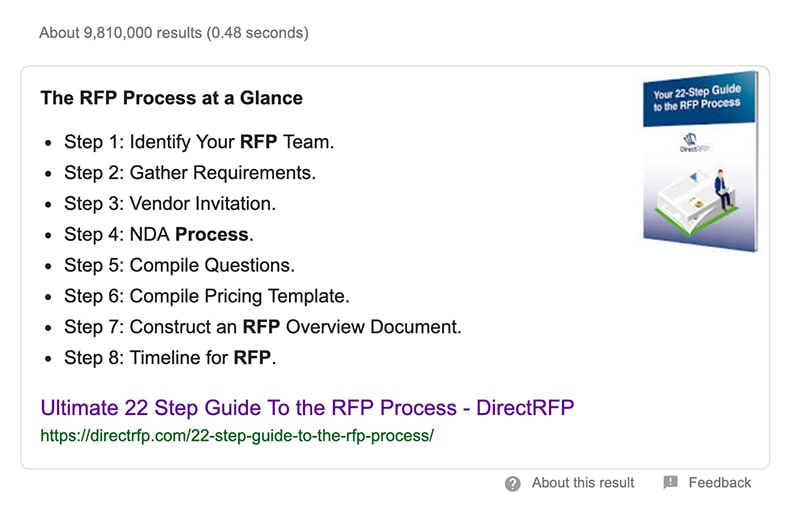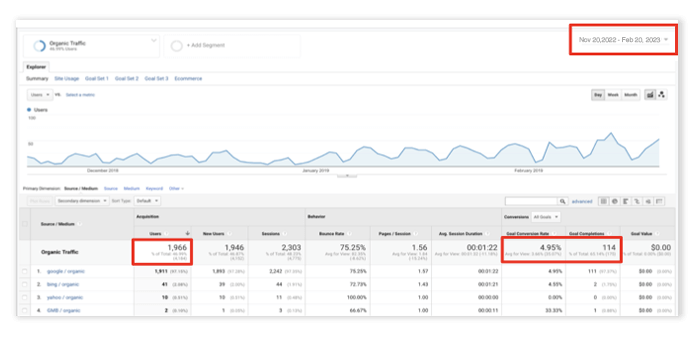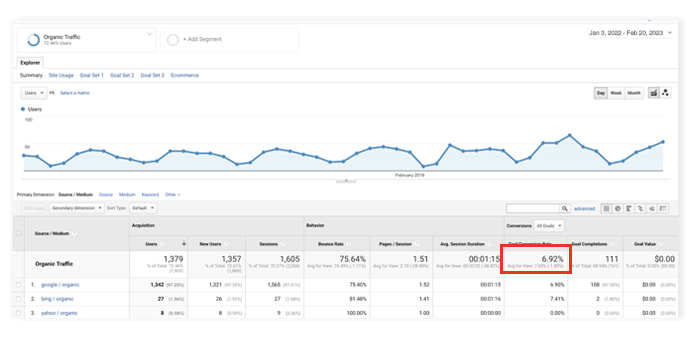How TPM Helped A Digital Startup Increase Organic Traffic by 111% in Just 4 Months

More than 835,000 startups emerge worldwide each day (or approximately 305 million annually). But only around 10% survive to become full-fledged businesses. Creating a viable — and valuable — product is only the first step on the journey to success. Startups that want to survive and thrive need something more than a little seed funding and a can-do attitude.
This is the story of how TPM helped DirectRFP, a scrappy SaaS with a revolutionary idea, climb to the top of Google search rankings and get the attention it deserved. Using a pillar content strategy, we helped them increase organic traffic by 111% in just four months and achieve a conversion rate of 6.92% — unheard of in the B2B world.
The Background
Businesses of all sizes have, for years, depended on a time-consuming, costly, inefficient manual process to build and distribute RFPs (requests for proposals). And DirectRFP had a plan to change that.
The team at DirectRFP developed a software-as-a-service (SaaS) platform that automated, simplified, and streamlined the entire process — eliminating 90% of the manual tasks typically involved in building, sharing, and evaluating responses to RFPs. The solution was revolutionary, and they were confident any organization that leveraged their tool would recognize the benefits immediately.
The Challenge
But no one knew DirectRFP existed. They simply did not have the reach — or the credibility — needed to introduce their innovative new tool to their audience.
They needed to make a name for themselves. The faster, the better.
Like many growing startups in the beta phase of development, DirectRFP was rich in technical and product expertise. But in terms of marketing resources, they came up short. Fortunately, the CEO had experienced the results TPM could deliver at another organization — and she reached out to the team for assistance.
“TPM made our vision a reality and helped us achieve — and surpass — our goals in a very short time. We’re excited to continue working with them and to see how their efforts support our continued growth.”
— VP, DirectRFP
Meeting with TPM chief Dean Ara, she shared her vision and goals for the startup. She was confident that their product would change lives and save huge amounts of money if DirectRFP could only get it in front of its target audience. But with little in the way of a budget for promotion, the campaign to bring the solution to the world was going to have to happen on the cheap. The plan was simple but ambitious:
- Create a site showcasing the benefits of their solution over traditional approaches
- Get people to the site with an organic marketing campaign
The Strategy
Building a compelling site was easy. A rapid increase in organic traffic was a different beast. But the TPM team was up to the challenge — they proposed using a pillar content strategy to help attract DirectRFP’s target audience and establish them as an expert in their field.
A pillar content strategy relies on the development of one key piece of content (the “pillar”) based on a high-value keyword with a significant amount of traffic. Once the pillar is published, other content on related keywords, or topic clusters, is developed a cross-linked with the central asset.
With a plan in place, TPM got to work.
Building a Site
Work began on a DirectRFP site that would support the pillar content strategy efforts. Like any business web presence, it had to be engaging, easy to navigate, and seamlessly funnel visitors to the content optimized for the pillar strategy. But that was not enough. TPM also optimized their content efforts with intuitive pop-ups, chat boxes, and other CTAs throughout the site — all guiding visitors to the downloadable pillar page.
Making It Shine
Then came the bigger task: building an organic pipeline of traffic to the optimized site. This was a multi-step process.
- Researching topic clusters and keywords that could boost DirectRFP’s ranking in Google search results
- Evaluating keywords, their rankings, search volumes, and competition to select a base for the pillar post
- Identifying supporting keywords and related topic clusters for content around the pillar
- Auditing DirectRFP’s existing blog posts and optimizing them with new keywords
- Documenting popular questions and phrases that could boost DirectRFP’s standing in Google’s related searches, “People Also Ask” boxes, and featured snippets
- Compiling a list of topics based on the topic cluster research
- Write, design, and publish a downloadable PDF (the pillar) that would attract the interest of DirectRFP’s target audience
- Create blog posts related to the pillar content, based on research around keywords, searches, and topic clusters
A pillar keyword was identified, and the production team leapt into action, building a PDF that walked readers through all the steps needed to create an RFP and blog posts surrounding the subject.


The PDF and the first few blog posts went live on the site in late November 2022.
The Results
Both DirectRFP and TPM had high hopes for the plan. And the pillar content strategy began delivering results almost immediately. Site traffic started to climb, and conversions far exceeded the industry average.
Organic Traffic (Nov 20 to Feb 20)

Nearly a 5% conversion rate. Almost unheard of in B2B technology.
Organic Traffic (Jan 3 to Feb 20)

By January of 2023, DirectRFP saw a 59% increase in month-over-month organic traffic from June 2023 with a conversion rate of 6.92%!
TPM continued to publish related blog posts to DirectRFP’s site, ensuring the flow of organic traffic would keep growing.
